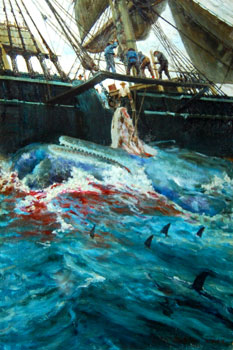Hauling in
Before anyone could rest, the whale had to be towed back to the mother ship, cut up into pieces and processed as sharks helped themselves to the bounty. Once the whale boat reunited with the whaler, it was time to chain the whale to the starboard side of the ship. The captain, comparing the length of the ship to the dimensions of the whale, estimated the size of the whale and the barrels of oil that it would yield. Sometimes the pleased captain ordered the tired, hungry crew to enjoy a meal before starting the tough work ahead.
Cutting In
All men and boys now concentrated on butchering the whale. Wooden planks with a railing were lowered over the side of the bark for the captain and mates to begin the processes of "cutting in." They used long, sharp spades to slice a hole into the whale body just above one of the fins. A crew member did the dangerous, slippery job of threading a huge hook through the hole in the blubber. Now the crew on board "heaved away", or pulled on the hook's chain that was secured to the vessel's masthead. As the ship leaned towards the whale, the mates and captain cut long strips of blubber.
Huge pieces of skin and fat, called blanket pieces, peeled off the whale in long strips like the skin of an orange. Using the windlass, successive long slabs of blubber weighing about one ton each were hoisted up onto the deck. They were lowered down a hatch that lead to the blubber room. Here, some crew members cut blanket pieces into "horse" pieces. These smaller chunks were tossed back onto the deck and sliced into layers that resembled thick pages in a book, consequently called "bible leaves."

Courtesy of the Trustees of the New Bedford Free Public Library